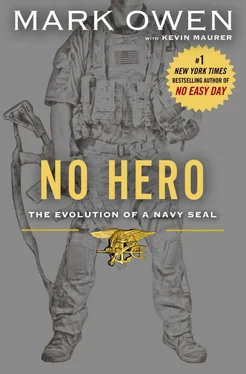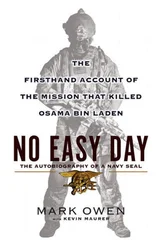Now, when I hear the drone of the C-130 propellers, I’m excited. I’m the one cracking jokes and looking forward to the views as I silently glide under canopy to the drop zone.
It took me a long time to get that comfortable. To get there, I faced my fear head-on. I volunteered for every jump trip I could at the beginning of my career. I didn’t like it, but I knew that if I was going to get any better at it, I was going to have to make myself jump every opportunity I got. The Navy SEALs motto is “The only easy day was yesterday,” and throughout my career that was a fact. I always pushed myself and never sat back and rested. I pushed myself every chance I got and tried to make myself better. Each day was always harder than my last.
Slowly I learned to overcome the fear of jumping. I am still not a huge fan of heights, but skydiving doesn’t faze me now.
On the ride back to the hotel after the uncontrolled spin, I started to feel better and knew I would handle the same situation better the next time. I couldn’t help thinking back to being on the rock face all those years earlier and the simple advice I’d gotten from the human billy goat, back before I’d seen any combat and before I really knew what fear was.
“Hey, man, stay in your three-foot world.”

CHAPTER 4
The Hooded Box
Stress
I wasin complete darkness.
I could feel the weight of multiple sets of eyes all focused on me. Sweat rolled off my forehead, making the fabric of the hood stick to my face. People were moving around and talking, but I couldn’t make out what they were saying. All of my senses—except my eyes—were hypersensitive as I strained to pick up anything that could help me when the hood came off.
I had been on two deployments—including one rotation to Iraq—before I was picked for the S&T course. When it was my turn to enter the box, I slid a magazine full of Simunitions, a paint cartridge created by General Dynamics that can be fired through our rifles, into my weapon and walked to the center of the room. Lights hung from the unfinished ceiling and a catwalk crisscrossed the room, allowing instructors to watch the action from above. The concrete floor was clean. A square box was taped onto the floor at one side of the room. I stood in the middle of the box and the instructors lowered the hood over my head. We couldn’t move outside of the taped lines or the exercise would end.
The hood and a rope that was tied to it were attached to a pulley system. When the instructors yanked the rope, the hood came off and I’d have to react to the scenario in front of me. Under the hood, I didn’t know if I would have to react to a hostage situation, deal with unarmed but violent bystanders, or handle compliant individuals who could become hostile in a split second. The scenario might be something I’d never encountered before.
Unlike BUD/S, which tested a candidate’s will more than anything else, S&T was all about skill, mental control, and the ability to make the right decision under enormous stress and pressure. I had to be able to quickly assess the situation, prioritize the threats, and act accordingly, all with the instructors watching from the catwalk and cataloging every action. Everything was graded to the finest point: One mistake could mean an early exit from the course and a ride back to SEAL Team Five.
I took two deep breaths and closed my eyes as the hood came down to rest on my shoulders. I wiggled my fingers and grabbed the pistol grip of my rifle, my finger lying across the trigger housing. I tried to relax. I knew if I was tense and not thinking clearly I would make a mistake. I didn’t think about any what-ifs. I trusted that I would know what to do. The question was whether I would be able to make the right life-or-death decisions quick enough and in the correct order. The S&T course forces you to stretch beyond your three-foot world.
Fear and stress are two different things.
Staying in your three-foot world is one of the keys to managing fear. But stress is harder to manage because it is usually coming from outside your control. The instructors did their best to throw more stress at us than we could handle.
As the seconds ticked off under the hood, it became harder and harder to stay focused. It felt like the instructors were just fucking with me by making me wait. Maybe they just wanted to see how long I’d stand at the ready. Maybe they were all just standing there laughing at me under the hood. I wiggled my hands again and shifted my weight from foot to foot, trying not to let my mind wander.
I knew it wouldn’t take more than a few seconds, a minute at most, but every second under the hood felt like a year.
Then, without warning, the hood was gone.
The light hit me like a flashbulb. I immediately started to scan the room with my rifle up and at the ready. Not ten feet in front of me stood a cute blond woman. I could see her soft brown eyes looking at me. She was wearing jeans and a T-shirt. She smiled at me like she knew something I didn’t.
Not seeing a weapon in her hands, I scanned past her. I caught a glimpse of a gunman, dressed in a team ball cap, T-shirt, and cargo pants, over the girl’s shoulder. He was in the back right corner of the room holding a black semiautomatic pistol to a man’s head. The hostage had his head down, and I couldn’t see his face.
Not even thinking about it, I’d already shouldered my gun and my eyes were already looking through my sights. He didn’t say anything as I set the red dot of my EOTech sight on his head.
“Hey, buddy,” I heard over my shoulder. “Hey, asshole!”
“Holy shit,” I thought. I hadn’t even looked behind me. “Fuck, I’m already spiraling out of control.” I hadn’t even taken a look at the entire room. I was too focused on the two threats in front of me.
I flipped my safety off and fired off two quick shots. The paint rounds exploded on the gunman’s chest. I knew I needed to take care of the immediate threat with the hostage first. Even if there were armed people behind me, in my mind at that moment, the hostage situation was the first priority. I watched the gunman drop his pistol and drop to the ground next to the hostage in a piss-poor attempt to play dead.
Even though the gunman was now dead, I felt as if I’d already screwed up. I hadn’t even assessed the entire room. I was in too much of a rush. Early on in my career, I had a hard time slowing things down because we were trained to do everything at full speed.
During my first deployment to Iraq with SEAL Team Five, we ran to the door and up the stairs with lots of yelling and screaming during every raid. Hell, when we arrived in Iraq, nobody in my platoon had any combat experience. It was the first deployment for most of the platoon. We were basically making it up as we went along.
We set up our camp behind a palace that sat on a massive man-made hill on the outskirts of Baghdad International Airport. From the roof of the palace, I could see the airport spread out in front of me. Military aircraft—big gray C-130s and C-17s—lumbered down the runways. There seemed to be a constant hum of engines and the thump of helicopter rotors. Baghdad International Airport was a massive hub for Coalition forces. HUMVEES and LMTV trucks kicked up dust on the dirt roads that led from the airfield to the tent cities where the troops lived. Contractors raced around in four-by-four trucks, and every day a new field of modular trailers sprang up to be used for sleeping or to serve as offices for the various companies.
A Special Forces team occupied the main palace. A massive wooden door opened into a foyer with marble floors. Stairs led up to the second-floor rooms. There was a chow hall built on the back, and the operations center took over one of the downstairs rooms. As I walked around the palace, I could see the design work on the marble and the fine craftsmanship on the banister. But looters had stolen most of the valuables before we arrived. Massive holes in the walls were everywhere. The rumor during the invasion was Saddam’s palaces had gold pipes, so looters all over Iraq punched holes in the walls looking to make a little cash.
Читать дальше











